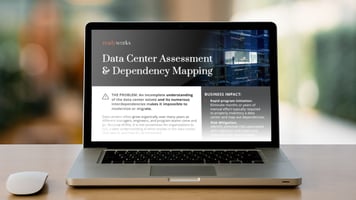Whether you’re replacing aging on-prem infrastructure, migrating unsupported servers, or consolidating resources following M&A activities, the first and most critical step is getting an accurate and comprehensive view of your estate.
For most organizations, data centers have grown organically over time as different teams have come and gone. As a result, getting a complete and accurate inventory of servers, applications, databases, hardware, and who is accessing what requires in-depth data discovery and analysis.
You’ll need:
- Current IT estate assessment: Discovery tools relying on network scans only see part of the picture. This information must be aggregated with existing systems of record and validated via stakeholder surveys and interviews to build a clear view of the data center.
- Risk assessment: With an asset inventory available, you should again work with other teams to identify the potential risks to your data center migration, including which applications are critical, what the dependencies are, and if regulatory requirements mean that some assets must remain on-prem. You don’t want to break access, leave data exposed, or risk non-compliance fines.
- Future needs assessment: If you want to save costs and meet the needs of the business going forward, don’t simply migrate what you’ve relied on in the past. You only want to pay for what you need and what will support you going forward, so a ‘lift and shift’ approach may not be for you, and it may not allow you to take full advantage of the cloud (if that’s your migration goal).Work with stakeholders to identify current and future business needs, and understand what could be archived, eliminated, or consolidated.
Manual processes take time and create bad data
Depending on the complexity of your organization, data discovery and analysis could take several months to complete if managed using spreadsheets and manual processes. And over that time, the organization will have evolved. That means you’ll be starting your migration with out-of-date information that could add risk to your program.
- Unfortunately, this process is highly manual and results in months or years of upfront effort before any modernization or migration activities can occur. Manual processes also introduce significant risks caused by bad data in your CMDB and other systems.
Learn how ReadyWorks can automate your data center assessment and shave months of data discovery.
DOWNLOAD THE SOLUTION BRIEFAutomate the data chase using a digital platform conductor
Using a digital platform conductor (DPC), a tool highlighted in four Gartner hype cycles, you can automate manual tasks to cut the data chase and dramatically reduce the time and risk of your migration.
A DPC does this by connecting to all your data sources – Including your data discovery tools, your CMDBs, configuration platforms, identity management platforms, and more – and automatically aggregating and analyzing the data they hold.
Additionally, a DPC:
- Identifies data gaps and anomalies and triggers automated emails to data owners to fill those gaps, using responses to automatically populate your view.
- Leverages templates that you can tailor for user and SME communications and surveys to automate additional information gathering.
- Leverages two-way connectors, to correct your source data with updated information, as you receive it.
- Continues to update your view as source data is updated, so you aren’t working with old information.
- Provides you with a holistic picture of your IT assets and all interdependencies.
Ensono accelerates data center migration by 7 months.
Read the case studyRapidly complete your IT estate view
Using a DPC, no server, application or other IT endpoint is left behind during a migration. See how a DPC can cut the data chase to complete your data center assessment.
ReadyWorks is a DPC. Book a demo to understand how ReadyWorks can cut the data chase and cost of managing your data center assessment to build a strong foundation for a successful migration.


